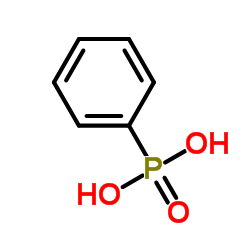Phenylphosphonic acid

Phenylphosphonic acid structure
|
Common Name | Phenylphosphonic acid | ||
|---|---|---|---|---|
| CAS Number | 1571-33-1 | Molecular Weight | 158.092 | |
| Density | 1.4±0.1 g/cm3 | Boiling Point | 353.7±25.0 °C at 760 mmHg | |
| Molecular Formula | C6H7O3P | Melting Point | 162-164 °C(lit.) | |
| MSDS | Chinese USA | Flash Point | 167.7±23.2 °C | |
| Symbol |


GHS05, GHS07 |
Signal Word | Danger | |
|
Molecularly imprinted polymer dedicated to the extraction of glyphosate in natural waters.
J. Chromatogr. A. 1361 , 1-8, (2014) Three molecularly imprinted polymers (MIPs) have been synthesized in order to bind efficiently glyphosate (GLY) in natural waters (mineral and underground). Since the target analyte is polar and hydrophilic, electrostatic interactions and hydrogen bonds have ... |
|
|
Specific recognition of tyrosine-phosphorylated peptides by epitope imprinting of phenylphosphonic acid
J. Chromatogr. A. 1293 , 85-91, (2013) • We developed an epitope imprinting approach for pTyr peptide capture by MIPs. • PPA, a characteristic component of phenylphosphate group was used as template. • MIPs showed good selectivity and clear preference for pTyr peptide over pSer. • MIPs performed m... |
|
|
Carbonic anhydrase inhibitors. Interaction of isozymes I, II, IV, V, and IX with organic phosphates and phosphonates.
Bioorg. Med. Chem. Lett. 15 , 1683-6, (2005) The interaction of five human carbonic anhydrase (hCA, EC 4.2.1.1) isozymes, that is, hCA I, II, IV, V, and IX with a small library of phosphonic acids/organic phosphates, including methylphosphonic acid, MPA; phenylphosphonic acid, PPA; N-(phosphonoacetyl)-L... |
|
|
Further observations on the uptake and effects of phosphonates in perfused rat liver studied by (31)P-NMR.
NMR Biomed. 12(5) , 275-85, (1999) We examined the route of uptake of 2-aminoethylphosphonate (NEthPo) and of phenylphosphonate (PhePo; 10 mM each) in perfused liver by (31)P-NMR. Uptake of NEthPo was concentrative. The rate of uptake was reduced to 21 +/- 2% (n = 3; all percentages refer to c... |
|
|
Large-area formation of self-aligned crystalline domains of organic semiconductors on transistor channels using CONNECT.
Proc. Natl. Acad. Sci. U. S. A. 112 , 5561-6, (2015) The electronic properties of solution-processable small-molecule organic semiconductors (OSCs) have rapidly improved in recent years, rendering them highly promising for various low-cost large-area electronic applications. However, practical applications of o... |
|
|
Phosphonates as 31P-NMR markers of extra- and intracellular space and pH in perfused rat liver.
NMR Biomed. 10(6) , 263-70, (1997) We evaluated phosphonates (Po) as markers of the extra- and intracellular space in perfused rat liver. (i) In- and outwash behaviour of phenylphosphonate (PhePo), 3-amino-propylphosphonate (NProPo) and methyl phosphonate (MePo) was compared with that of creat... |
|
|
Inhibition of 1-deoxy-D-xylulose-5-phosphate reductoisomerase by lipophilic phosphonates: SAR, QSAR, and crystallographic studies.
J. Med. Chem. 54 , 4721-34, (2011) 1-Deoxy-D-xylulose-5-phosphate reductoisomerase (DXR) is a novel target for developing new antibacterial (including antituberculosis) and antimalaria drugs. Forty-one lipophilic phosphonates, representing a new class of DXR inhibitors, were synthesized, among... |
|
|
Spectroscopic imaging of circular voxels with a two-dimensional Fourier-series window technique.
J. Magn. Reson. B 105(3) , 225-32, (1994) Spatial localization with the spectroscopic imaging technique is normally implemented with the Fourier-transform approach, yielding rectangular voxels, with potentially significant cross-voxel contamination. Multidimensional Fourier-series window (FSW) is an ... |
|
|
Phosphate transport into the sarcoplasmic reticulum of skinned fibres from rat skeletal muscle.
J. Muscle Res. Cell Motil. 18(2) , 161-7, (1997) The rate, magnitude and pharmacology of inorganic phosphate (Pi) transport into the sarcoplasmic reticulum were estimated in single, mechanically skinned skeletal muscle fibres of the rat. This was done, indirectly, by using a technique that measured the tota... |
|
|
In situ crystallized zirconium phenylphosphonate films with crystals vertically to the substrate and their hydrophobic, dielectric, and anticorrosion properties.
Langmuir 26(1) , 179-82, (2010) The in situ crystallization technique has been utilized to fabricate zirconium phenylphosphonate (ZrPP) films with their hexagonal crystallite perpendicular to the copper substrate. The micro/nano roughness surface structure, as well as the intrinsic hydropho... |